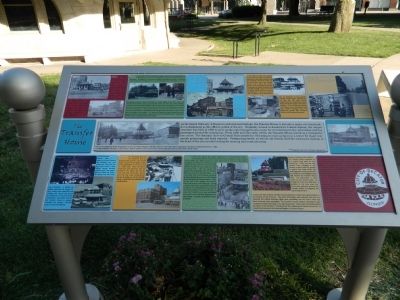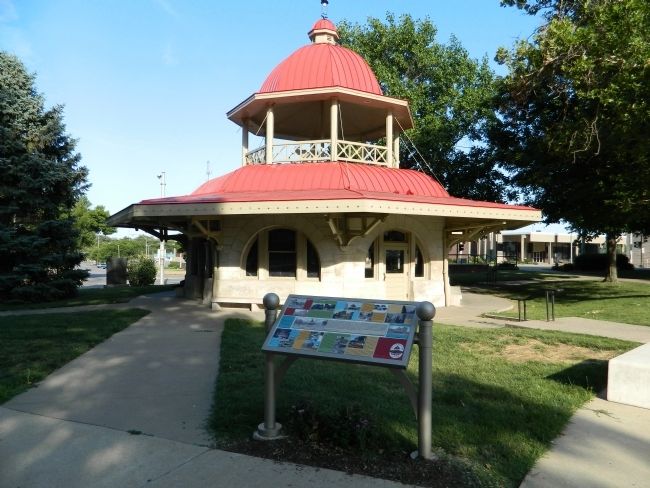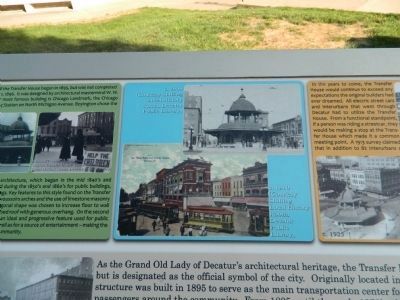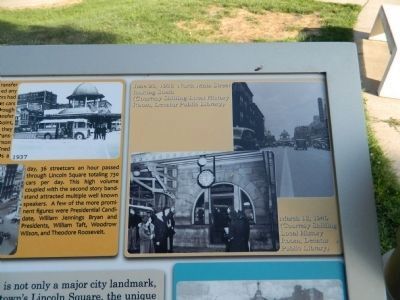Decatur in Macon County, Illinois — The American Midwest (Great Lakes)
The Transfer House
Erected by City of Decatur.
Topics. This historical marker is listed in these topic lists: Notable Buildings • Railroads & Streetcars. A significant historical year for this entry is 1895.
Location. 39° 50.567′ N, 88° 57.216′ W. Marker is in Decatur, Illinois, in Macon County. Marker is on North Park Street just west of North Franklin Street. Touch for map. Marker is in this post office area: Decatur IL 62523, United States of America. Touch for directions.
Other nearby markers. At least 8 other markers are within walking distance of this marker. Music Please, Maestro (within shouting distance of this marker); Lincoln's Legacy (within shouting distance of this marker); Birthplace of the Grand Army of the Republic (within shouting distance of this marker); The Railsplitter Candidate (about 300 feet away, measured in a direct line); Finding the Biggest Man (about 400 feet away); Stephen Decatur (about 500 feet away); Wake Up, Lincoln! (about 500 feet away); Choosing a President (about 600 feet away). Touch for a list and map of all markers in Decatur.
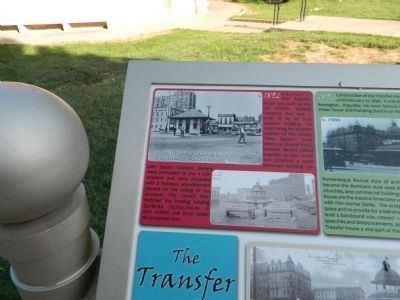
Photographed By Bill Pfingsten, June 8, 2012
3. The Transfer House 1892
Decatur's first Transfer House was built by the City Electric Railway Company and was a small 18 by 20 foot wooden building. To avoid losing the transfer location to the nearby "New Square" (now known as Central Park), business leaders pulled together to raise funds and construct a more prominent building. Lincoln Square business owners were persuaded to pay a subscription and were rewarded with a business advertisement painted on the ceiling of the structure. City Council then matched the funding totaling $3,080.84 ($2,830,000.00 in 2010 dollars) just $0.50 under the projected cost.
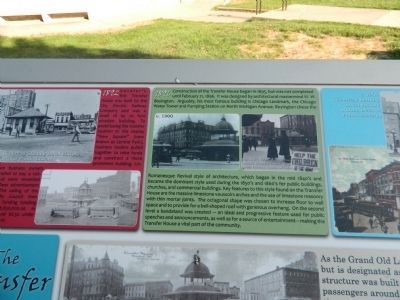
Photographed By Bill Pfingsten, June 8, 2012
4. The Transfer House 1896
Construction of the Transfer House began in 1895, but was not completed until February 21, 1896. It was designed by architectural mastermind W. W. Boyington. Arguably, his most famous building is Chicago Landmark, the Chicago Water Tower and Pumping Station on North Michigan Avenue. Boyington chose the Romanesque Revival style of architecture, which began in the min 1840's and became the dominant style used during the 1850's and 1860's for public buildings, churches, and commercial buildings. Key features to this style found on the Transfer House are the massive limestone voussoirs arches and the use of limestone masonry with thin mortar joints. The octagonal shape was chosen to increase floor to wall space and to provide for a bell-shaped roof with generous overhang. On the second level a bandstand was created - an ideal and progressive feature used for public speeches and announcements, as well as for a source of entertainment - making the Transfer House a vital part of the community.
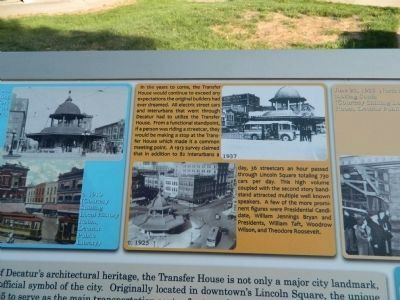
Photographed By Bill Pfingsten, June 8, 2012
6. The Transfer House 1937
In the years to come, the Transfer House would continue to exceed any expectations the original builders had ever dreamed. All electric street cars and interurbans that went through Decatur had to utilize the Transfer House. From a functional standpoint, if a person was riding a streetcar, they would be making a stop at the Transfer House which made it a common meeting point. A 1913 survey claimed that in addition to 82 Interurbans a day, 36 streetcars an hour passed through Lincoln Square totaling 730 cars per day. This high volume coupled with the second story bandstand attracted multiple well known speakers. A few of the more prominent figures were Presidential Candidate, Williams Jennings Bryan and Presidents, William Taft, Woodrow Wilson, and Theodore Roosevelt.
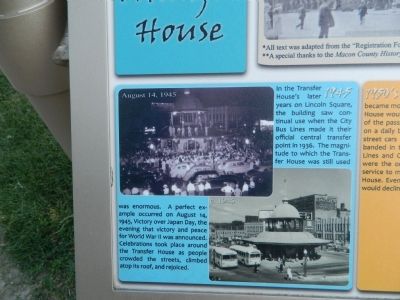
Photographed By Bill Pfingsten, June 8, 2012
8. The Transfer House 1945
In the Transfer House's later years on Lincoln Square, the building saw continual use when the City Bus Lines made it their official central transfer point in 1936. The magnitude to which the Transfer House was still used was enormous. A perfect example occurred on August 14, 1945, Victory over Japan Day, the evening that victory and peace for World War II was announced. Celebrations took place around the Transfer House as people crowded the streets, climbed atop its roof, and rejoiced.
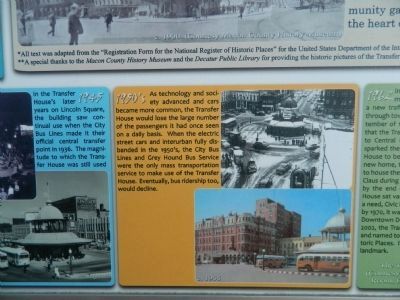
Photographed By Bill Pfingsten, June 8, 2012
9. The Transfer House 1950's
As technology and society advanced and cars became more common, the Transfer House would lose the large number of the passengers it had once seen on a daily basis. When the electric street cars and interurban fully disbanded in the 1950's, the City Bus Lines and Grey Hound Bus Service were the only mass transportation service to make use of the Transfer House. Eventually, bus ridership too, would decline.
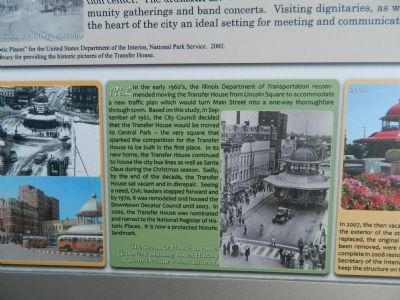
Photographed By Bill Pfingsten, June 8, 2012
10. The Transfer House 1962
In the early 1960's, the Illinois Department of Transportation recommended moving the Transfer House from Lincoln Square to accommodate a new traffic plan which would turn Main Street into a one-way thoroughfare through town. Based on this study, in September of 1962, the City council decided that the Transfer House would be moved to Central Park - the very square that sparked the competition for the Transfer House to be built in the first place. In its new home, the Transfer House continued to house the city bus lines as well as Santa Claus during the Christmas season. Sadly, by the end of the decade, the Transfer House sat vacant and in disrepair. Seeing a need, Civic leaders stepped forward and by 1970, it was remodeled and housed the Downtown Decatur Council until 2003. In 2002, the Transfer house was nominated and named to the National Register of Historic Places. It is now a protected historic landmark.
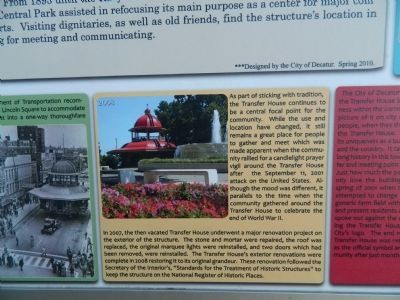
Photographed By Bill Pfingsten, June 8, 2012
11. The Transfer House 2008
As part of sticking with tradition, the Transfer House continues to be a central focal point for the community. While the use and location have changed, it still remains a great place for people to gather and meet which was made apparent when the community rallied for a candlelight prayer vigil around the Transfer House after the September 11, 2001 attack on the United States. Although the mood was different, it parallels to the time when the community gathered around the Transfer House to celebrate the end of World War II.
In 2007, the then vacated Transfer House underwent a major renovation project on the exterior of the structure. The stone and mortar were repaired, the roof was replaced, the original marquee lights were reinstalled, the two doors which had been removed were reinstalled. The Transfer House's exterior renovations were completed in 2008 restoring it to its original grandeur. These renovations followed the Secretary of the Interior's, "Standards for the Treatment of Historic Structures" to keep the structure on the National Register of Historic Places.
In 2007, the then vacated Transfer House underwent a major renovation project on the exterior of the structure. The stone and mortar were repaired, the roof was replaced, the original marquee lights were reinstalled, the two doors which had been removed were reinstalled. The Transfer House's exterior renovations were completed in 2008 restoring it to its original grandeur. These renovations followed the Secretary of the Interior's, "Standards for the Treatment of Historic Structures" to keep the structure on the National Register of Historic Places.
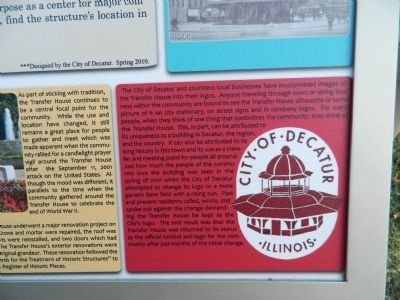
Photographed By Bill Pfingsten, June 8, 2012
12. City of Decatur
The City of Decatur and countless local businesses have incorporated images of the Transfer House into their logos. Anyone traveling through town or doing business within the community are bound to see the Transfer House silhouette or some picture of it on city stationary, on street signs and in company logos. For many people, when they think of one thing that symbolizes the community, they think of the Transfer House. This, in part, can be attributed to its uniqueness as a building in Decatur, the region, and the country. It can also be attributed to its long history in this town and its use as a transfer and meeting point for people all around. Just how much the people of the community love the building was ween in the spring of 2001 when the City of Decatur attempted to change its logo to a more generic farmfield with a rising sun. Past and present residents called, wrote, and spoke out against the change demanding the Transfer House be kept as the City's logo. The end result was that the Transfer House was returned to its status as the official symbol and logo for the community after just months of the initial change.
Credits. This page was last revised on June 16, 2016. It was originally submitted on June 28, 2012, by Bill Pfingsten of Bel Air, Maryland. This page has been viewed 890 times since then and 42 times this year. Photos: 1, 2, 3, 4, 5, 6, 7, 8, 9, 10, 11, 12. submitted on June 28, 2012, by Bill Pfingsten of Bel Air, Maryland.
